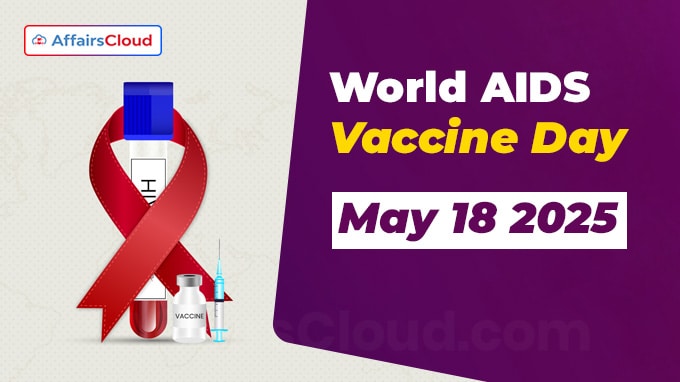 World AIDS Vaccine Day (WAVD), also known as HIV Vaccine Awareness Day (HVAD), is annually observed across the globe on 18th May to raise awareness about the urgent and ongoing need for a vaccine to prevent Human Immunodeficiency Viruses (HIV) and Acquired Immunodeficiency Syndrome (AIDS).
World AIDS Vaccine Day (WAVD), also known as HIV Vaccine Awareness Day (HVAD), is annually observed across the globe on 18th May to raise awareness about the urgent and ongoing need for a vaccine to prevent Human Immunodeficiency Viruses (HIV) and Acquired Immunodeficiency Syndrome (AIDS).
- The day also commemorates the unwavering efforts of researchers, volunteers, healthcare workers, and community advocates committed to developing a safe and effective HIV vaccine.
- 18th May 2025 marks the 28th observance of the WAVD.
Awareness Ribbon:
The red ribbon represents global support and awareness for those affected by HIV and AIDS, symbolizing unity and the commitment to stop new HIV infections by 2030.
Background:
i.The day 18th May commemorates the 1997 speech by former United States of America (USA) President Bill Clinton at Morgan State University at Maryland in the United States of America(USA), where he highlighted the urgent need for a preventive HIV vaccine.
ii.The first WAVD was observed on 18th May 1998 to mark the anniversary of Clinton’s speech.
About HIV and AIDS:
i.HIV is a virus that attacks and weakens the human immune system, specifically the CD4 cells (a type of white blood cell), which help the immune system fight infections.
ii.If left untreated, HIV typically progresses to AIDS, the most advanced stage of the infection, within 8 to 10 years.
iii.Causes: HIV spreads through specific body fluids such as blood, semen, vaginal fluids, rectal fluids, pre-seminal fluid, and breast milk.
iv.Symptoms:
- Early Stage (Acute HIV): Fever, headache, rash, sore throat, muscle and joint pain.
- Chronic Stage: May be asymptomatic for years but the virus continues to damage the immune system.
- AIDS Stage: Rapid weight loss, recurring fever, prolonged swelling of lymph glands, pneumonia, skin rashes, and neurological disorders.
v.Treatment:
- Antiretroviral Therapy (ART), the primary treatment for HIV, lowers the virus to undetectable levels, improves health outcomes, reduces transmission risk, and enables people with HIV to live longer.
- Currently, there is no vaccine to prevent HIV, but scientists worldwide, supported by the National Institutes of Health (NIH), are actively working to develop one.
- Broadly neutralizing antibodies (bNAbs), now in clinical trials, have shown safety and long-lasting effects, with some able to lower HIV levels.
About Advanced HIV Disease (AHD):
i.According to the World Health Organization (WHO), Advanced HIV Disease (AHD) is defined in individuals aged 5 years and above as having a CD4 cell count below 200 cells per cubic millimeter (cells/mm³) or being in clinical stage 3 or 4 of HIV.
ii.All children with HIV infection are considered to have AHD by default due to their high risk of rapid progression.
iii.Global health agencies such as WHO and UNAIDS (Joint United Nations Programme on HIV/AIDS) have identified AHD as a major barrier to ending the HIV epidemic by 2030.
Discovery of HIV:
i.In 1983, French scientists Luc Montagnier and Françoise Barré-Sinoussi at the Pasteur Institute in Paris (France) isolated a virus from a patient with lymphadenopathy (swollen lymph nodes) and named it LAV (Lymphadenopathy-Associated Virus).
ii.In 1986, the virus was officially renamed as HIV by the International Committee on the Taxonomy of Viruses (ICTV).
iii.In 2008, the Nobel Prize in Physiology or Medicine was jointly awarded to Luc Montagnier and Françoise Barré-Sinoussi for identifying Human Immunodeficiency Viruses (HIV) as the virus responsible for AIDS, and shared with Harald zur Hausen for discovering that Human Papilloma Viruses (HPV) cause cervical cancer.
Keyfacts:
According to the World Health Organization (WHO), as per the latest data available for 2023 (reported as of 22 July 2024), an estimated 39.9 million people were living with HIV globally.
During the same year, approximately 1.3 million individuals acquired HIV, while around 6.3 lakh (630,000) people died due to HIV-related causes.



